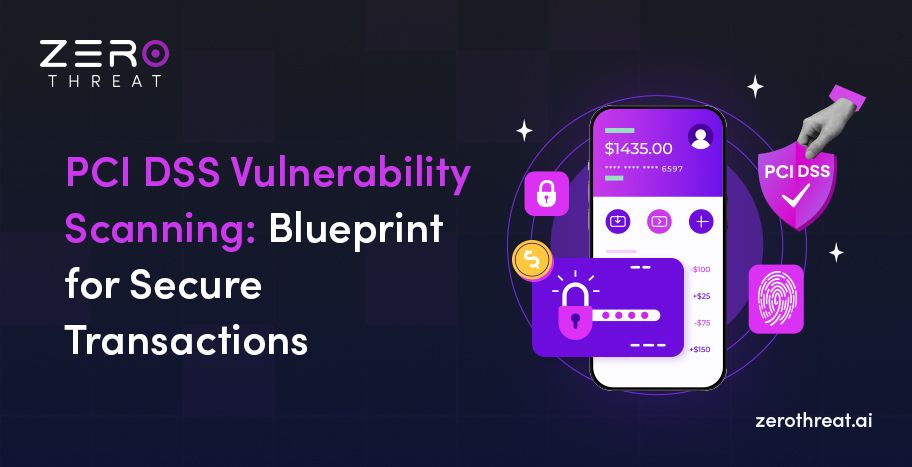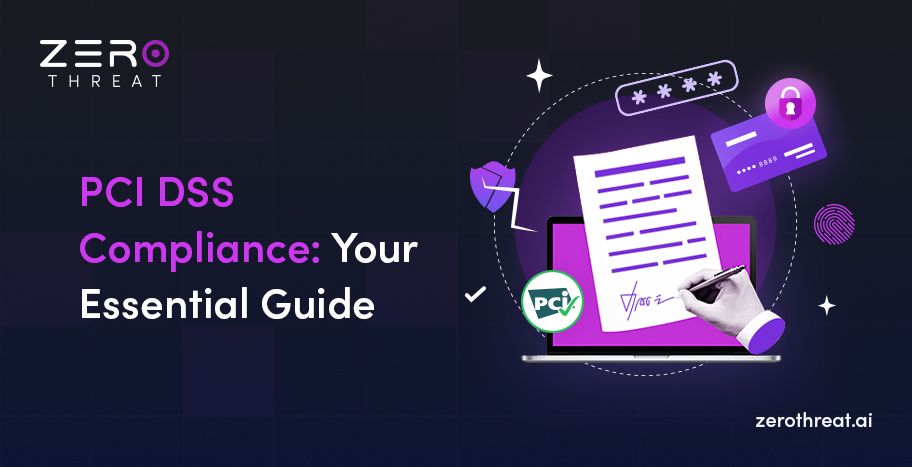All Blogs

Quick Summary: PCI vulnerability scanning is an important requirement to ensure compliance with the Payment Card Industry Data Protection Standard. This blog helps you understand it with the process to perform the scanning. You can get the necessary information to perform scans seamlessly and fulfill the requirements of the standard.
They say, “Don’t judge a book by its cover,” but your customers will surely judge you by your capability to protect their sensitive data. As a matter of fact, they won’t even give a second thought before ditching you if their data is exposed. On top of that, they will drag you to the courts of law.
So, protecting their data must be a priority and PCI DSS vulnerability scanning plays a vital role in it. You may implement as many security controls as you want, only regular vulnerability scanning can help you ensure they work flawlessly. And this is what the 11th requirement of PCI DSS is all about.
PCI DSS compliance in itself is a hallmark of trust. There are 12 essential requirements of PCI DSS that your organization must meet to comply with this standard and regular vulnerability scanning is one of them. This blog delves deeper into this realm to help you build a stronger security posture.
So, let’s start without further ado!
Earn Customer Trust and Build Reputation by Actively Identifying and Eliminating Risks with ZeroThreat Perform an Assessment for $0
On This Page
- Overview of PCI Compliance
- What is PCI DSS Vulnerability Scanning?
- Types of PCI Vulnerability Scans
- Importance of PCI DSS Scanning
- How to Perform PCI Scans?
- PCI Vulnerability Scanning vs PCI Pentesting
- How Many Times Should You Perform Scanning?
- ZeroThreat for PCI Vulnerability Scanning
A Quick Overview of PCI Compliance
PCI DSS is an important security compliance that aims to protect cardholder data from fraud and cyber threats. It is designed for organizations that store, process, and transfer credit card data, such as e-commerce, banking, and finance. PCI Security Standard Council is the governing body for this standard.
Your organization becomes PCI DSS compliant when it meets the minimum security requirements prescribed by this standard. It indicates that you have taken adequate security measures to protect cardholder data.
What is PCI DSS Vulnerability Scanning All About?
Put simply, a PCI vulnerability scan helps assess your current security posture to identify weaknesses that can threaten the security of cardholder data. It is an automated test that assesses your applications, systems, and networks to identify vulnerabilities and report them. It helps boost the security of your cardholder data environment (CDE).
Organizations, regardless of their size, are required to conduct internal and external vulnerability scans at least once a quarter which means 4 scans of each type in a year. The test is also conducted when there is a substantial change, such as moving cardholder data to a new server.
Plus, Different scanning techniques like authenticated and unauthorized scanning are used to discover vulnerabilities. It helps evaluate the possibility of a cyber-attack and strengthen security posture by eliminating weaknesses.
Types of Scans Under PCI Compliance Scan Requirement
Organizations are recommended to perform two kinds of scans as per PCI vulnerability scan requirements – external and internal scans. These two methods provide diverse perspectives to test applications, helping you uncover a wide range of security risks.
Let’s understand both external and internal scanning in detail.
Internal PCI Scanning
As the name itself implies, internal scanning involves vulnerability assessment within the bounds of your organization’s network. It identifies vulnerabilities in systems and services residing within the internal environment of an organization.
In simple words, these are vulnerability scans that work behind firewalls, examine internal IT environments, and are conducted through the internal network of an organization. This test helps identify vulnerabilities in workstations, networks, internal servers, etc.
Internal vulnerability scans help evaluate the possibility of cyber threats from a person or employee who has access to the servers and systems. For example, it helps discover the possibility of an insider attack.
External PCI Scanning
This type of vulnerability scanning is performed externally without access to the internal network or IT environment. It involves assessing public-facing applications and services. This type of vulnerability scanning helps identify real-world security risks posed by external threats.
Public-facing IPs are scanned externally. An intelligent vulnerability scanner can perform automated external scanning to uncover vulnerabilities seamlessly. It performs simulated attacks on the target application or API to identify vulnerabilities.
This type of scanning helps discover a wide range of vulnerabilities, including security misconfigurations, injections, broken authentication, and more.
The following image will help you understand the difference between these two scanning methods visually.

Is Conducting PCI DSS Vulnerability Scanning Worth It?
Now you may wonder, can we skip PCI DSS scanning, or what if we don’t conduct it? Since it involves costs, resources, and time, the question holds a valid status. While PCI compliance is not legally bound per se, there are significant repercussions that will have a drastic impact on your organization.
From loss of customer confidence and dwindling reputation to lawsuits, there are a wide array of negative implications. There are plenty of reasons why you would want to stay compliant with PCI DSS and conducting regular vulnerability scanning automatically comes with it.
So, what benefits can you reap from PCI vulnerability scanning? Let’s find out below.
- You can achieve PCI compliance while also creating a strong security shield for your cardholder data environment.
- Your operations can run smoothly and peacefully without any hidden potential security risks.
- Proactive security scanning helps you avoid downtime and disruption to your operations caused by security issues.
- Your organization can avoid penalties or legal actions by ensuring stricter data security policies.
- Regular security testing also sets foot for other compliances like GDPR, HIPAA, SOC2, etc.
It Takes Only a Few Minutes to Assess Your Applications to Prevent Costly Data Breaches Start an Assessment Now
How to Conduct PCI Vulnerability Scans?
Vulnerability scanning is a systematic process that helps discover weaknesses in applications, systems, and networks. The following are all the steps involved in this process.
Determine the Scope
Before any step, you need to define the scope of vulnerability scanning. It’s like setting goals before pursuing an activity. Determine which assets to be scanned and objectives. You need to identify the assets involved in storing, processing, and managing cardholder data.
Choose a Scanner
The next step is important because you have to choose a vulnerability scanner that fits your requirements and comes with advanced features. You have to consider multiple factors to choose the right vulnerability scanner, such as the rate of false positives, complexity, configuration, vulnerability coverage, etc.
Conduct or Schedule Scans
You can instantly conduct a vulnerability scan if required or schedule it for the day of the month of your choice. Automated scanning should be conducted continuously like every month or even daily. Whether you want to conduct the scans monthly or quarterly, you can schedule the scans accordingly. However, you should schedule scans at least once a quarter as per PCI compliance scan requirements.
Reporting
After conducting a scan with a vulnerability scanner, you will get a detailed report. The report will provide information about the vulnerabilities found, severity level, and potential risks. It will help prioritize and remediate vulnerabilities.
PCI Vulnerability Scanning vs PCI Penetration Testing
The main difference between vulnerability scanning and penetration testing is the testing approach. A vulnerability scan is a high-level automated test that identifies known security loopholes. On the other hand, penetration testing is a hands-on examination in which a tester will try to discover and exploit vulnerabilities.
Another way to know the difference is by understanding how heavy lifting is done. For example, in automated PCI scanning, a tool will perform the test and generate the report with minimal human intervention.
However, PCI penetration testing is human-driven and depends on the tester's knowledge and experience. Hence, it is more time-consuming and resource-intensive. The decision to choose between these two methods depends on PCI recommendations on testing.
As per the standard’s recommendations, the testing can be a self-assessment or a review by an external assessor. It depends on the volume of transactions handled by an organization. An automated vulnerability scan can be sufficient for self-assessment.
So, organizations with smaller volumes of transactions can choose automated scans for self-assessment. Organizations with larger volumes of transactions can hire an external assessor to perform penetration tests.
You can also combine both these approaches for better results with VAPT. It helps reduce your pen test efforts and helps discover vulnerabilities with greater accuracy.
How Often Do You Need to Conduct PCI Vulnerability Scan?
While conducting vulnerability scans is necessary, frequency is also important. Scanning once a year won’t work. The ideal frequency of scanning recommended by PCI compliance is once every three months (a quarter). So, you are required to conduct vulnerability scanning once a quarter.
This is the minimum requirement to meet the PCI compliance standard. Apart from this, you are also required to conduct vulnerability scans if there is a significant change or update to your digital assets or IT environment. It might be the deployment of a new server or a shift of cardholder data.
These scans will help discover weaknesses that could lead to sensitive data exposure. You can promptly take appropriate action to mitigate the possible risks.
Make Your CDE the Safest Place for Storing and Processing Credit Card Data Uncover Risks in Minutes
Leverage ZeroThreat’s AI-powered Vulnerability Scanning for PCI Compliance
Given the speed at which cyber threats are rising, regular security testing is the only way to protect your data. This helps you discover any weaknesses before an attacker finds them and hacks your systems. PCI compliance standards require regular testing of your systems and processes to protect cardholder data.
With stringent requirements of PCI standards, preparing for an audit is crucial to maintain your compliance. If you have a reliable security scanner, it will help with PCI compliance and reduce the roadblocks in the process. ZeroThreat’s AI-powered vulnerability scanner is one that you can rely on.
It helps streamline the process of vulnerability assessment with automated scans and minimize the overall efforts in this process. You can perform automated pentesting and vulnerability scanning to identify vulnerabilities in minutes and protect your cardholder data environment from cyber threats.
You can schedule scans as per your preference and choose the location of the scanning server to store data where it complies with local regulations. Learn more about it to know how it works.
Frequently Asked Questions
What challenges can we face in PCI scanning?
There can be a few challenges in the scanning process like identifying all systems and networks that are covered by PCI DSS, deciding the assessment’s scope accurately, and managing the vulnerabilities identified.
What is the ideal PCI DSS vulnerability scan frequency?
How much does a PCI vulnerability scan cost?
Explore ZeroThreat
Automate security testing, save time, and avoid the pitfalls of manual work with ZeroThreat.


